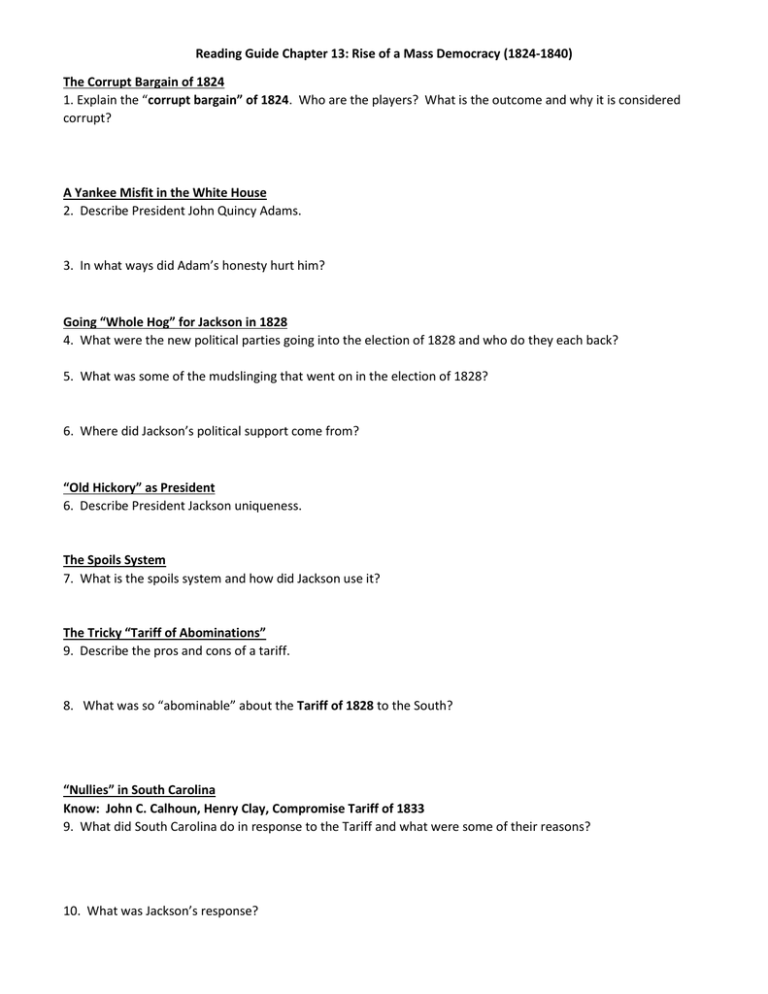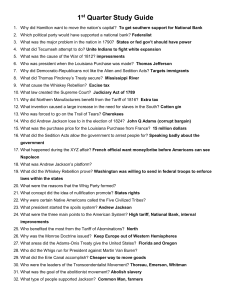Unit 3 reading guides 2015
advertisement

Reading Guide Chapter 13: Rise of a Mass Democracy (1824-1840) The Corrupt Bargain of 1824 1. Explain the “corrupt bargain” of 1824. Who are the players? What is the outcome and why it is considered corrupt? A Yankee Misfit in the White House 2. Describe President John Quincy Adams. 3. In what ways did Adam’s honesty hurt him? Going “Whole Hog” for Jackson in 1828 4. What were the new political parties going into the election of 1828 and who do they each back? 5. What was some of the mudslinging that went on in the election of 1828? 6. Where did Jackson’s political support come from? “Old Hickory” as President 6. Describe President Jackson uniqueness. The Spoils System 7. What is the spoils system and how did Jackson use it? The Tricky “Tariff of Abominations” 9. Describe the pros and cons of a tariff. 8. What was so “abominable” about the Tariff of 1828 to the South? “Nullies” in South Carolina Know: John C. Calhoun, Henry Clay, Compromise Tariff of 1833 9. What did South Carolina do in response to the Tariff and what were some of their reasons? 10. What was Jackson’s response? 11. How did Clay end the nullification crisis? The Trail of Tears Know: Cherokee Indians v. Georgia, Black Hawk War 12. Who were the “Five Civilized Tribes” and what made them “civilized”? 13. What was the Indian Removal Act of 1830 and its consequences? The Bank War 14. What was Jackson’s problem with the Bank of the United States? 15. Explain the Bank War of 1832—include winners and losers. “Old Hickory” Wallops clay in 1832 16. What was the Anti-Masonic party and what was its role in the Election of 1832? Burying Biddle’s Bank Know: pet banks, Specie Circular 17. How did Jackson finally kill the BUS and what was the impact on the economy? The Birth of the Whigs 18. Who joined the Whig party? 18. What issues did the Whigs stand for? The Election of 1836 19. What party and candidate win in 1836 and why did the Whigs not manage much of a fight? Big Woes for the “Little Magician 19. Why did Van Buren have such a rough time as president? Depression Doldrums and the Independent Treasury Know: Divorce Bill 19. Describe the panic of 1837 and proposed solutions. Gone to Texas 20. Who invited American’s to Texas and what kind of people were supposed to come? 21. What were the issues between the Texans and the Mexicans? The Lone Star Rebellion 22. What happened at the Alamo? 23. Who helped Texas defeat Santa Anna? 24. Why was Texas not granted annexation when first proposed in 1837? Log Cabins and Hard Cider of 1840 25. What helped Harrison win the election of 1840? Politics for the People & The Two-Party System 26. What two major changes in American politics were demonstrated by the election of 1840? Varying Viewpoints: What was Jacksonian Democracy? 27. Summarize each of the historical views of Jackson and his democracy. Reading Guide Chapter 14: Forging the National Economy (1790-1860) The Westward Movement Know: Rugged Individualism 1. Describe what was life was like for most pioneers in the West. Shaping the Western Landscape Know: ecological imperialism 2. How did the wild, unspoiled character of the land define America’s uniqueness? What did it inspire? The March of the Millions 3. Describe the reasons for and impact of urbanization. The Emerald Isle Moves West (read also the Makers of America: The Irish) Know: Molly Maguires 4. Discuss the Irish immigrants: where did they live, how did they live and what was the reaction of Americans? 5. How did Irish immigrants affect (influence) the United States? (Social, economic, political influences) The German Forty-Eighters (read also the Maker of America: The Germans pg 288) 6. Discuss the German immigrants: where did they live, how did they live and what was the reaction of Americans? 7. How did German immigrants affect (influence) the United States? (social , economic, political influences) Flare-ups of Antiforeignism Know: Know-Nothing Party 8. How did American nativists feel about the new immigrants? What were the specifically alarmed by? 9. What political party was created by the nativist movement? What were the goals of the party? 10. What were some of the actions taken against immigrants, specifically Catholics during this time? 11. What role did the economy play in keeping these clashes to a minimum? Creeping Mechanziation 12. Why was the Industrial Revolution so slow to catch on in America? List at least 4 reasons. 13. Why was Samuel Slater considered the “Father of the Factory System” in America? Whitney Ends the Fiber Famine Know: the Cotton Gin 14. What impact did Eli Whitney have on the cotton industry? 15. Describe the different roles the North and the South had in the cotton industry. Marvels in Manufacturing Know: Limited liability 16. What impact did inventions have on American manufacturing? (know at least two) Workers and “Wage Slaves” 17. How did the factory system change society? Be specific. Women and the Economy Know: Lowell factory Girls, cult of domesticity 18. What opportunities did women have at this time to be self-sufficient? 19. What kind of power did women have at this time? Western Farmers Reap a Revolution in the Fields Know: McCormick Reaper 20. How did technological advances improve agricultural production? Highways and Steamboats Know: turnpike, Cumberland Road, steamboats 21. What transportation innovations change the economy? (be sure to know at least TWO) 22. What impact did transportation innovations have on sectional relationships? “Clinton’s Big Ditch” in New York 23. What impact did the creation of the Erie Canal have on America? The Iron Horse 24. What obstacles did the railroads face at first? Cables, Clippers, and Pony Riders 25. Explain the significance of clipper ships. 26. What led to the demise of the pony express? The Transport Web Binds the Union 27. Explain the significance of the transportation Revolution. The Market Revolution 28. What was the market revolution? 29. What legal questions did it raise? Reading Guide Chapter 15: The Ferment of Reform and Culture (1790-1860) Reviving Religion Know: Peter Cartwright 1. What were the doctrines and beliefs of Deism? 2. Why is the Second Great Awakening considered to be one of the most momentous episodes in the history of American Religion? 3. What were the main events of the Second Great Awakening? 4. Why was revivalist preacher Charles Grandison Finney so well known? 5. How did the Second Great Awakening bring about the feminization of religion? Explain what that is. Denominational Diversity 6. Why was Western New York called the Burned-Over District? 7. How did religions differ on the issue of slavery? A Desert Zion in Utah 8. What is the Utah connection to the Second Great Awakening? (if you are unfamiliar with the story of the Mormon migration you will want to know it, it is covered on the test) Free Schools for a Free People Know: Horace Mann, Noah Webster 9. How and why did education change during this time including teacher training? Higher Goals for Higher Learnig 10. How did higher education change? 11. How did women’s education change and what impact did Catherine Beecher have? An Age of Reform 12. How did the Second Great Awakening influence reform movements that followed in its wake? 13. How did the criminal justice system change during the era of reform? 14. Who is Dorothea Dix and what was her contribution to this era of reform? Demon Rum—The “Old Deluder” Know: American Temperance Society, Maine Law of 1851 15. What is temperance and why did this reform movement emerge? 16. According to some, in what ways was alcohol hurting society? Women in Revolt 17. What is the cult of domesticity? 18. How did women begin stepping out of their “separate sphere” at home and challenging traditional roles in society? 19. Why and how did women begin to demand the right to vote? 20. What were the contribution of the following to women’s rights? Lucretia Mott Elizabeth Cady Stanton 21. What is the Seneca Falls Conference and why is it important? Wilderness Utopias Know: New Harmony, Brook Farm, Oneida Community, Shakers (know two) 22. What were Utopian societies trying to accomplish? Use two of the above communities as your example. The Dawn of Scientific Achievement 23. Describe the early scientific achievements during this time. Artistic Achievements 24. How did architecture change during this time? 25. What was the Hudson River School and what was it most known for? The Blossoming of a National Literature 26. How did romanticism influence literature written during this time? 27. Choose one of the following romantic authors and list their famous works and philosophies. *Washington Irving *James Fenimore Cooper Trumpeters of Transcendentalism 28. What is transcendentalism? 29. What were the major views of the following transcendentalists and what did they write? Ralph Waldo Emerson Henry David Thoreau Walt Whitman Glowing Literary Lights 30. Choose two of the following authors and summarize their body of work *Henry Wadsorth Longfellow *John Greenleaf Whittier *James Russell Lowell *Louisa May Alcot *Emily Dicksonson *William Gilmore Simms Literary Individualists and Dissenters 31. Choose one of the following contrary-minding authors and summarize their body of work *Edgar Allen Poe *Nathaniel Hawthorne *Herman Melville Portrayers of the Past 32. Why is George Bancroft considered the father of American History, and what did these early historians have in common? Reading Guide Chapter Sixteen: The South and the Slavery Controversy (1793-1860) “Cotton is King!” 1. How did Cotton become King in the south? 2. Both southern ___________ and Northern ___________ profited from slavery and the cotton trade. 3. In what way did Great Britain condone American slavery? 4. In what ways was Cotton King and how did the south believe the British would react to a war between the North and the South? The Planter “Aristocracy” 5. Why was the south referred to as an aristocracy and what role did women play in this aristocracy? Slaves of the Slave System 6. What were some of the economic disadvantages of “King Cotton?” The White Majority 7. How did the south end up the most Anglo-Saxon section of the nation? 8. What % of white southerners owned slaves or belonged to a slave owning family? 9. Why did the non-slave owning whites in the south defend slavery so fiercely? 10. What role did the mountain whites play in the upcoming Civil War and why? Free Blacks: Slaves Without Masters 11. How did free blacks fare in the South? 12. How were freed blacks treated in the North? Plantation Slavery 13. What fact distinguished slavery in America from other New World societies? 14. How did the view of slaves as a commodity impact their treatment (for good and for bad)? Life Under the Lash 15. Describe how slavery varied within the South. 16. How did slaves maintain their own unique culture? The Burdens of Bondage Know: Gabriel, Denmark Vesey, Nat Turner, Amistad 15. Why was education specifically prohibited for slaves? 16. In what ways did slaves resist without rebelling? 17. List some slave rebellions of the early 1800’s and what they had in common. Early Abolitionism Know: American Colonization Society, Liberia 18. What were some of the solutions to the “peculiar institution”? Radical Abolitionism Know: The Liberator, American Anti-Slavery Society, Appeal of the Colored Citizens of the World 19. Using a Venn-diagram compare and contrast William Lloyd Garrison and Frederick Douglass on the back of this paper. The South Lashes Back Gag Resolution 20. In what ways did the southern states react to the abolitionism of the North? 21. How did southerners defend slavery? The Abolitionist Impact in the North 22. What negative reaction to abolition existed in the North?





